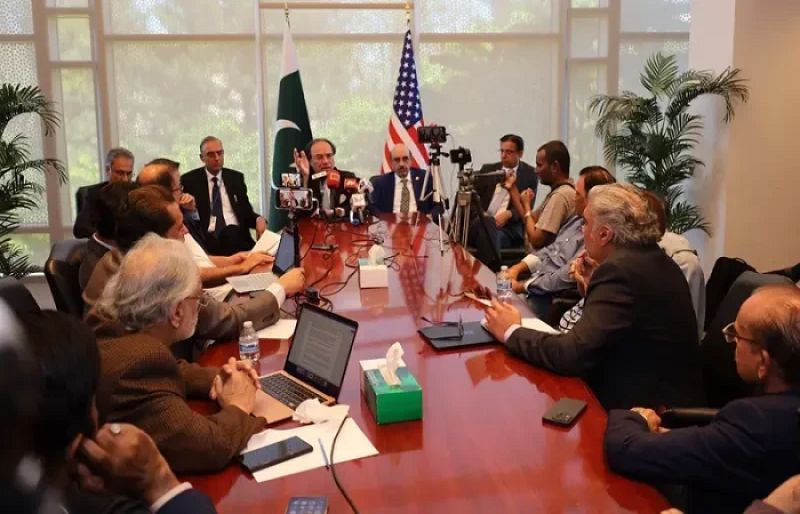Business
Aurangzeb set to represent Pakistan at IMF, World Bank meetings in Washington – SUCH TV

Finance Minister Senator Mohammad Aurangzeb is set to leave for the United States to attend the annual meetings of the International Monetary Fund (IMF) and the World Bank (WB).
Earlier, the finance minister virtually addressed a business session arranged for the visiting Saudi business delegation at the Overseas Investors Chamber of Commerce and Industry (OICCI) in Karachi.
The event was jointly hosted by OICCI and the Pakistan Business Council (PBC).
Expressing gratitude to both organizations for the invitation, Aurangzeb said he regretted not being able to attend in person due to his imminent departure for Washington to participate in the IMF and World Bank meetings.
Recalling his recent meeting with His Highness Prince Mansour and members of the Saudi delegation at a luncheon hosted by the Prime Minister, the minister reaffirmed Pakistan’s commitment to empowering the private sector as the main driver of economic growth, with the government acting as a facilitator by ensuring an enabling environment.
Highlighting Pakistan’s improving macroeconomic indicators, Aurangzeb said that stability had been restored, with all three major global rating agencies now aligned after several years. He added that stable financing rates, a steady exchange regime, and healthy reserves had made capital and profit repatriation a routine matter.
Referring to Pakistan’s timely repayment of a US$500 million Eurobond on September 30, he remarked, “When there is macroeconomic stability, such events become non-events — there is no drama.”
Aurangzeb noted that while the government had made significant progress on economic stabilization, it was also advancing structural reforms in taxation and the energy sectors through a consultative process with the private sector.
He acknowledged the valuable input of OICCI and PBC in shaping these reforms and appreciated the growing strategic partnership with Saudi Arabia, particularly under the guidance of His Excellency Al-Tuwaijri, citing the Kingdom’s Vision 2030 as a model of successful execution.
The minister reiterated Pakistan’s focus on strengthening export-led growth — a key driver for sustainable development — and informed participants that the Federal Cabinet had recently approved the historic Security Pact signed between Crown Prince Mohammed bin Salman and Prime Minister Shehbaz Sharif.
He termed this development a significant step in deepening the multifaceted ties between the two brotherly countries.
He said Pakistan currently enjoys a unique confluence of favorable factors – macroeconomic stability and positive geopolitical tailwinds – with longstanding partners such as Saudi Arabia, China, and the United States engaging with us on trade and investment, emphasizing that the Saudi delegation’s visit is both timely and strategically important in unlocking new avenues of bilateral cooperation.
On the domestic front, Senator Aurangzeb said that the government is finalizing rapid damage assessments following recent floods and will prioritize the use of domestic resources for rescue and relief operations before considering external assistance for rehabilitation and reconstruction.
Regarding the ongoing engagement with the International Monetary Fund, the Minister reaffirmed that talks with the IMF mission remain constructive, with only a few outstanding issues, and expressed optimism about reaching a staff-level agreement shortly during his upcoming meetings in Washington.
Addressing His Highness Prince Mansour and the Saudi business delegation, the Finance Minister commended the thought leadership and professionalism of Pakistan’s private sector, represented by OICCI and PBC.
He noted that the session would highlight key sectors of mutual interest including agriculture, mining, IT, pharmaceuticals, and tourism, while presenting concrete project opportunities.
The Minister also apprised the participants of two major reform tracks being personally led by the Prime Minister on taxation reforms and Pakistan’s digital transformation towards a cashless economy.
He pointed out that while Pakistan’s recorded economy stands at US$411 billion, nearly half remains undocumented, implying that “the real size of our economy is close to a trillion dollars.”
He added that digitization and documentation will be pivotal in broadening the tax base and improving fiscal discipline.
Concluding his remarks, Senator Aurangzeb extended his best wishes to His Highness Prince Mansour and the Saudi delegation for their engagements in Karachi and Lahore, and expressed hope for fruitful deliberations and enhanced investment partnerships between the business communities of both countries.
He also looked forward to meeting the Saudi leadership again during the forthcoming Future Investment Initiative (FII) in Riyadh.
Business
Peel Hunt cheers ‘positive steps’ in Budget to boost London market and investing

UK investment bank Peel Hunt has given some support to under-pressure Chancellor Rachel Reeves over last week’s Budget as it said efforts to boost the London market and invest in UK companies were “positive steps”.
Peel Hunt welcomed moves announced in the Budget, such as the stamp duty exemption for shares bought in newly listed firms on the London market and changes to Isa investing.
It comes as Ms Reeves has been forced to defend herself against claims she misled voters by talking up the scale of the fiscal challenge in the run-up to last week’s Budget, in which she announced £26 billion worth of tax rises.
Peel Hunt said: “Following a prolonged period of pre-Budget speculation, businesses and investors now have greater clarity from which they can start to plan.
“The key measures were generally well received by markets, particularly the creation of additional headroom against the Chancellor’s fiscal rules.
“Initiatives such as a stamp duty holiday on initial public offerings (IPOs) and adjustments to the Isa framework are intended to support UK capital markets and encourage investment in British companies.
“These developments, alongside the Entrepreneurship in the UK paper published simultaneously, represent positive steps toward enhancing the UK’s attractiveness for growth businesses and long-term investors.”
Ms Reeves last week announced a three-year stamp duty holiday on shares bought in new UK flotations as part of a raft of measures to boost investment in UK shares.
She also unveiled a change to the individual savings account (Isa) limit that lowers the cash element to £12,000 with the remaining £8,000 now redirected into stocks and shares.
But the Chancellor also revealed an unexpected increase in dividend tax, rising by 2% for basic and higher rate taxpayers next year, which experts have warned “undermines the drive to increase investing in Britain”.
Peel Hunt said the London IPO market had begun to revive in the autumn, although listings activity remained low during its first half to the end of September.
Firms that have listed in London over recent months include The Beauty Tech Group, small business lender Shawbrook and tinned tuna firm Princes.
Peel Hunt added that deal activity had “continued at pace” throughout its first half, with 60 transactions announced across the market during that time and 10 active bids for FTSE 350 companies, as at the end of September.
Half-year results for Peel Hunt showed pre-tax profits jumped to £11.5 million in the six months to September 30, up from £1.2 million a year earlier, as revenues lifted 38.3%.
Peel Hunt said its workforce has been cut by nearly 10% since the end of March under an ongoing savings drive, with full-year underlying fixed costs down by around £5 million.
Steven Fine, chief executive of Peel Hunt, said: “The second half has started strongly, with the group continuing to play leading roles across both mergers and acquisitions and equity capital markets mandates.”
Business
Gross GST collections for November stand at over Rs 1.70 lakh crore; up 0.7 per cent – The Times of India

GST collections: The Gross Goods and Services Tax (GST) collections for the month of November came in at over Rs 1.70 lakh crore. This is a rise of 0.7%, according to official data.SBI Research in a report in November had estimated that the gross domestic GST collections may come around Rs 1.49 lakh crore for November 25 (returns of October 25 but filed in Nov’25), a YoY growth of 6.8%.“Coupled with Rs 51,000 crore of IGST and cess on Import, the November GST collections thus could cross Rs 2.0 lakh crore, driven by the peak festive season demand led by lower GST rate and increased compliance while most of states experience positive gains,” SBI Research had said.This story is being updated
Business
Key Financial Deadlines That Have Been Extended For December 2025; Know The Last Date

New Delhi: Several crucial deadlines have been extended in December 2025, including ITR for tax audit cases, ITR filing and PAN and Aadhaar linking. These deadlines will be crucial in ensuring that your financial affairs operate smoothly in the months ahead.
Here is a quick rundown of the important deadlines for December to help you stay compliant and avoid last-minute hassles.
ITR deadline for tax audit cases
The Central Board of Direct Taxes has extended the due date of furnishing of return of income under sub-Section (1) of Section 139 of the Act for the Assessment Year 2025-26 which is October 31, 2025 in the case of assessees referred in clause (a) of Explanation 2 to sub-Section (1) of Section 139 of the Act, to December 10, 2025.
Belated ITR filing deadline
A belated ITR filing happens when an ITR is submitted after the original due date which is permitted by Section 139(4) of the Income Tax Act. Filing a belated return helps you meet your tax obligations, but it involves penalties. You can only file a belated return for FY 2024–25 until December 31, 2025. However, there will be a late fee and interest charged.
PAN and Aadhaar linking deadline
The Income Tax Department has extended the deadline to link their PAN with Aadhaar card to December 31, 2025 for anyone who acquired their PAN using an Aadhaar enrolment ID before October 1, 2024. If you miss this deadline your PAN will become inoperative which will have an impact on your banking transactions, income tax return filing and other financial investments.
-

 Sports1 week ago
Sports1 week agoWATCH: Ronaldo scores spectacular bicycle kick
-

 Entertainment1 week ago
Entertainment1 week agoWelcome to Derry’ episode 5 delivers shocking twist
-

 Politics1 week ago
Politics1 week agoWashington and Kyiv Stress Any Peace Deal Must Fully Respect Ukraine’s Sovereignty
-

 Business1 week ago
Business1 week agoKey economic data and trends that will shape Rachel Reeves’ Budget
-

 Tech6 days ago
Tech6 days agoWake Up—the Best Black Friday Mattress Sales Are Here
-

 Politics1 week ago
Politics1 week ago53,000 Sikhs vote in Ottawa Khalistan Referendum amid Carney-Modi trade talks scrutiny
-

 Fashion1 week ago
Fashion1 week agoCanada’s Lululemon unveils team Canada kit for Milano Cortina 2026
-

 Tech6 days ago
Tech6 days agoThe Alienware Aurora Gaming Desktop Punches Above Its Weight











